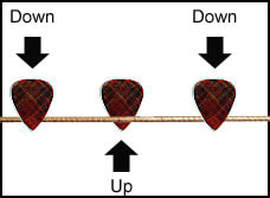 Beginners often under-appreciate just how difficult it is to play evenly in time but playing in time is as important as any other aspect of playing an instrument because a universal common denominator in all music is time. Technology has availed both metronomes, drum beat apps and videos with drum beats for free or nearly free. The best free Android metronome I've tried is called “metronome beats”. And for Apple devices, “metronome plus” is great. The first thing to consider when practicing with a metronome/drum beat is volume. Your metronome needs to be louder than you are so that you can clearly hear each click. Another great option to make practicing more pleasant is to play along with drum beats. An advantage of this is that drum beats contain more parts you can take cues from to maintain good timing as compared to a metronome which is typically either clicking in quarter or eighth notes plus it simulates the real world experience of playing with a drummer. YouTube has an incredible number of drum beat backing tracks available and you can specify the genre of music and tempo you'd like, for example: a Chicago blues shuffle at 120 bpm. (beats per minute) Lastly, here's some advice for playing with a metronome: As a beginner, you should practice primarily against quarter notes, that means you will play one note per click of the metronome. Then, when you're consistently good at that, practice playing eighth notes against the metronome in quarter notes and practice quarter notes against the metronome in eighth notes.  Playing the guitar or bass is very much an exercise of coordination or synchronization. Your right hand must be synced with your left hand, your pick must be synced with the strings, your left hand must be synced with the strings and the frets and your playing has to be synced with the band and the tempo. In the same way that when you tap your foot, it's down on the beat and up on the ands, (the off beat) your pick too should generally be down on the beat and up on the ands, especially when playing eighth notes. This reinforcement of both your foot and pick being down on the beats and up on the ands will eventually lead to a strong sense of where the beat is, which is critical to becoming a competent musician. Alternate picking (picking down and up) needs to be practiced to the point of automaticity. A caveat with picking down on the beat and up on the ands occurs with quarter notes – I recommend that beginners play quarter notes with alternate picking which puts the down picks on beats one and three and the up picks on beats two and four. Once you've gotten to the point of alternate picking being completely subconscious, then you can play slower quarter notes with down pick. |
AuthorEric Hankinson Archives
December 2023
Categories
All
|
|
The Chromatic Watch Company
(my other business) |
|

 RSS Feed
RSS Feed

